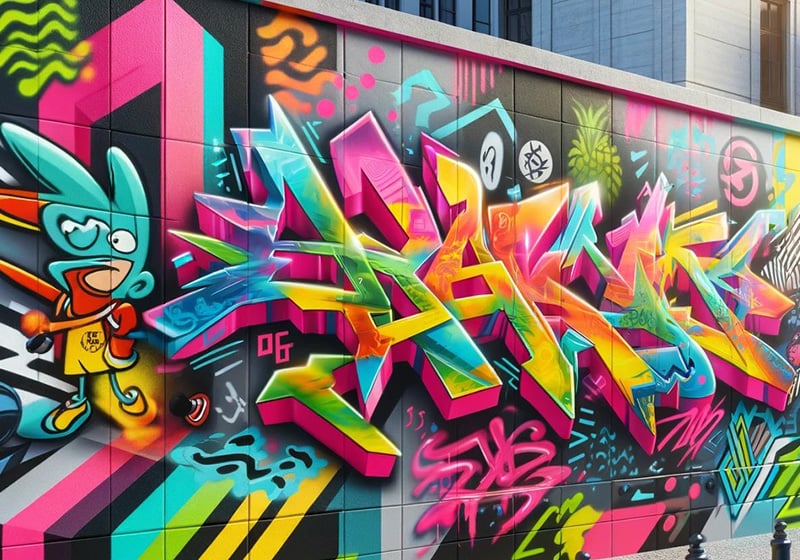Table of Contents
Fluorescent colours are electric, bright, shiny and… very eighties! But they actually first appeared a lot earlier – at the start of the previous century, to be precise – and they have never really gone away.
Since then, fluorescent colours have come back into fashion in regular cycles, appearing in the most unusual array of items and designs: illuminated signs, attention-grabbing jackets, music videos, film posters, irreverent make-up, boots, jewellery and much more besides!
Electric blue, neon orange, fuchsia, bright green and more: here, for your reading pleasure, we present the history and some interesting facts about fluorescent colours.
What are fluorescent colours?
Fluorescent colours do not appear in this form in the colour wheel; they are extremely bright and luminous – fluorescent, in other words – versions of existing colours.

Primary colours produce the most interesting fluorescent hues, creating neon red, electric blue and bright yellow. Then there is also fuchsia and various shades of fluorescent green. Basically, if you’re thinking of putting together a fluorescent palette, you’ve got plenty of options.
Creating a fluorescent effect in print requires a special technique reserved for professionals, but here are some useful HEX codes if you’d like to use fluorescent colours on the web:
- Neon red: #FF3131
- Chartreuse: #DFFF00
- Hot magenta: #FF44CC
- Electric blue: #0FF0FC
How did fluorescent colours come about? The history of neon lights and fluorescence
Fluorescent colours are a relatively recent invention: they’ve been with us for just over a century. The occasion they were first revealed to the world can be pinpointed to an exact time and place: the 1910 Paris Motor Show.
This was the first time a neon lamp – probably neon red in colour – was displayed following its invention by the French engineer Georges Claude.
Neon lighting is made from a piece of transparent glass with the air removed and neon gas neon added instead. An electrical discharge ionises the gas, causing it to emit a yellowy orange light.

The mechanism behind fluorescent lamps is slightly different and a little more complex. Instead of neon, other noble gases are normally used like argon, xenon or krypton, paired with mercury. The coloured light emitted does not come straight from the gas, but is caused by the mercury atoms reacting with the fluorescent material on the surface of the glass tube. Changing this fluorescent material gives you the typical fluorescent colours: bright blue, green, and pinkish orange. The first fluorescent lamp was patented in 1927 by the German inventors Friedrich Meyer, Hans Spanner and Edmund Germer.
Although technically their origins are different, the terms neon and fluorescent colours are normally used interchangeably.
Neon signs: from the first sign in Paris to the American metropolis

When Georges Claude presented his invention to the world, it was love at first sight. Apparently, the first ever neon sign was put up by a hairdresser’s on Boulevard Montmartre in Paris, featuring the words ‘Palais Coiffeur’ lit in a futuristic red neon light.
This sign immediately inspired countless other shops and businesses, including across the Atlantic, where it became a major trend between the 1920s and 1950s. Take, for instance, the iconic display of neon signs in Times Square: the first was installed in 1924 to advertise Willys-Overland Motors.

In the years that followed, neon colours took over Las Vegas and Hollywood, the city of cinema. In the 1930s, neon colours could be found in almost every major American city, and they remained fashionable until the end of the 1950s.
It was only in the 1960s that fluorescent signs started to be replaced by other technologies, and at the same time people concerns began to grow about the use of lead in early neon lamps. However, the quintessential fluorescent decade was still to come: the legendary 1980s.
The fluorescent-tinged eighties

Whenever you think about fluorescent colours, your imagination immediately takes you to a precise era: the 1980s. And for good reason.
During this decade of individualism and excess, fluorescent colours became practically ubiquitous. Everything was taken to extremes, becoming garish, vibrant and powerful. And the use of colour was no exception.
Fluorescent things worth remembering from this period include Whitney Houston and Boy George’s make up, Madonna’s sweaters and accessories, Prince’s jackets, the graphics from Back to the Future, the video for Michael Jackson’s Thriller… and we’re sure you could add many more cult favourites to this list!

Contemporary fluorescence? Neon colours today
Many artists and cultural figures, including a philosopher, have described neon as a symbol of the twentieth century. Pop artist Andy Warhol even said once that neon is one of the great objects of the modern era.
So what has happened to fluorescent colours in the 2000s? Neon and fluorescent light have been replaced by LEDs, which can easily mimic their colour, but the power of fluorescent colours certainly does not seem to be waning.
Indeed, in the art world, fluorescent colours never seem to have gone away. In the 1990s, British artist Fiona Banner exhibited what she called the smallest neon in the world at Tate Britain: a full stop. More recently, Chilean artist Ivan Navarro used neon to investigate the political, economic and social connotations of our everyday lives.

But fashion and brands seem to go through phases of loving fluorescent colours, and some people have even called them Generation Z’s favourite hues. Various celebrities – including Kim Kardashian, Emily Blunt, Selena Gomez, Brad Pitt and, of course, Dua Lipa – are very fond of appearing in public in the brightest possible attire and accessories.
And neon colours seem to have conquered the world of cinema too. Julia Ducournau’s Titane – winner of the Palme d’Or at Cannes in 2021 – uses them extensively in its sets, costumes, lights and even its posters; while Denis Villeneuve makes copious use of fluorescent orange, pink and purple in his remake Blade Runner 2049.

How about you? Would you consider using fluorescent colours in an upcoming project?

